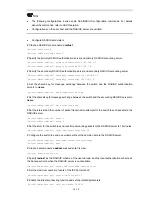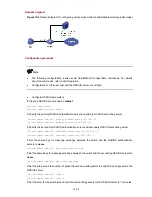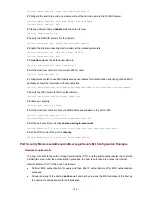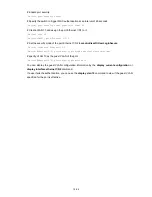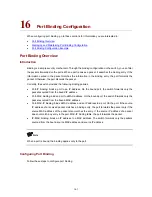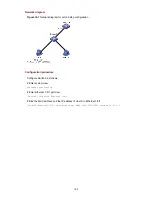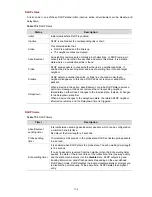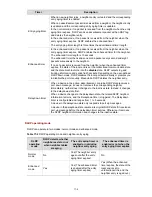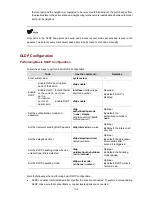
DLDP packet type
Function
RSY-Advertisement
packets (referred to as
RSY packets hereafter)
Advertisement packet with the RSY flag set to 1. RSY advertisement
packets are sent to request synchronizing the neighbor information when
neighbor information is not locally available or a neighbor information
entry ages out.
Flush-Advertisement
packets (referred to as
flush packets hereafter)
Advertisement packet with the flush flag set to 1. A flush packet carries
only the local port information (instead of the neighbor information) and is
used to trigger neighbors to remove the information about the local
device.
Probe
Probe packets are used to probe the existence of a neighbor. Echo
packets are required from the corresponding neighbor. Probe packets
carry the local port information. Neighbor information is optional for probe
packets. A probe packet carrying neighbor information probes the
specified neighbors; A probe packet carrying no neighbor information
probes all the neighbors.
Echo
Response to probe packets. An echo packet carries the information about
the response port and the neighbor information it maintains. Upon
receiving an echo packet, a port checks whether the neighbor information
carried in the echo packet is consistent with that of itself. If yes, the link
between the local port and the neighbor is regarded as bidirectional.
Disable
Disable packets are used to notify the peer end that the local end is in the
disable state. Disable packets carry only the local port information instead
of the neighbor information. When a port detects a unidirectional link and
enters the disable state, the port sends disable packets to the neighbor. A
port enters the disable state upon receiving a disable packet.
LinkDown
Linkdown packets are used to notify unidirectional link emergencies (a
unidirectional link emergency occurs when the local port is down and the
peer port is up). Linkdown packets carry only the local port information
instead of the neighbor information. In some conditions, a port is
considered to be physically down if the link connecting to the port is
physically abnormal (for example, the Rx line of the fiber on the port is
disconnected, while the Tx line operates properly). But for the peer end,
as Rx signals can still be received on the physical layer, the port is still
considered to be normal. Such a situation is known as unidirectional link
emergency.
When a unidirectional link emergency occurs, DLDP sends linkdown
packets immediately to inform the peer of the link abnormality. Without
linkdown packets, the peer can detect the link abnormality only after a
period when the corresponding neighbor information maintained on the
neighbor device ages out, which is three times the advertisement interval.
Upon receiving a linkdown packet, if the peer end operates in the
enhanced mode, it enters the disable state, and sets the receiving port to
the DLDP down state (auto shutdown mode) or gives an alarm to the user
(manual shutdown mode).
Recover Probe
Recover probe packets are used to detect whether a link recovers to
implement the port auto-recovery mechanism. Recover probe packets
carry only the local port information instead of the neighbor information.
They request for recover echo packets as the response. A port in the
DLDP down state sends a recover probe packet every two seconds.
Recover Echo
Recover echo packets are response to recover probe packets in the port
auto-recovery mechanism. A link is considered to restore to the
bidirectional state if a port on one end sends a recover probe packet,
receives a recover echo packet, and the neighbor information contained
in the recover echo packet is consistent with that of the local port.
17-3


